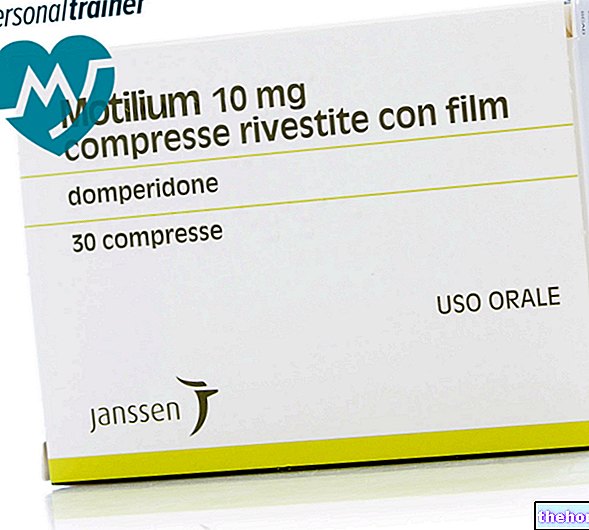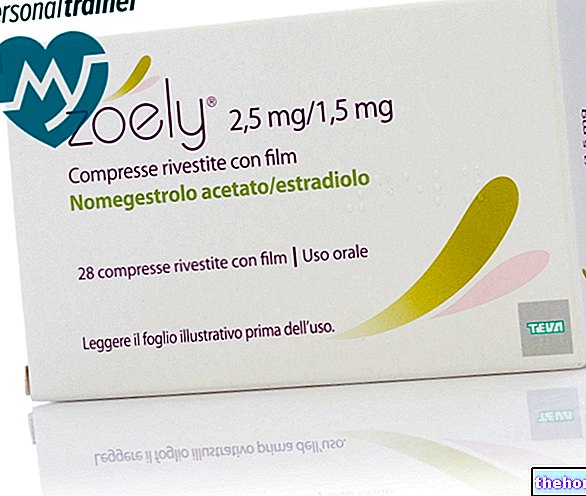Active ingredients: Propanteline (Propanteline bromide), Bromazepam
Lexil® 15 mg + 1.5 mg hard capsules
Why is Lexil used? What is it for?
Pharmacotherapeutic group
Lexil belongs to the therapeutic category of antispasmodics associated with psycholeptics.
Indications
Spastic-painful manifestations, with an anxious component, of the gastro-enteric system.
Contraindications When Lexil should not be used
Glaucoma, prostatic hypertrophy and, in general, urinary retention and intestinal obstruction syndromes.
Hypersensitivity to the active substances or to any of the excipients.
Myasthenia gravis. Severe heart, renal, hepatic insufficiency.
First trimester of pregnancy, breastfeeding.
Precautions for use What you need to know before taking Lexil
During the Lexil effect, patients should refrain from consuming alcoholic beverages to avoid any individual reactions (see "Interactions" and "Special warnings").
Predisposed subjects, if treated with bromazepam at high doses and for prolonged periods, may be addictive as occurs with other drugs with hypnotic, sedative and ataraxic activity.
In case of prolonged treatment it is advisable to check the blood picture and liver function.
Interactions Which drugs or foods may change the effect of Lexil
Concomitant intake with alcohol should be avoided (see "Precautions for use" and "Special warnings"). The sedative effect may be enhanced when the medicinal product is taken in conjunction with alcohol. This adversely affects the ability to drive or use machines. Combination with central nervous system depressants: Central depressive effect may be enhanced in cases of use. concomitant with antipsychotics (neuroleptics), hypnotics, anxiolytics / sedatives, antidepressants, narcotic analgesics, antiepileptics, anesthetics and sedative antihistamines. In the case of narcotic analgesics, an increase in euphoria can occur, leading to an increase in psychic dependence.
Compounds that inhibit certain liver enzymes (especially cytochrome P450) may increase the activity of benzodiazepines. To a lesser extent, this also applies to benzodiazepines which are metabolised only by conjugation. Concomitant administration of cimetidine may prolong the elimination half-life of bromazepam. Tell your doctor or pharmacist if you are taking or have recently taken any other medicines, even those obtained without a prescription.
Warnings It is important to know that:
The association with other psychotropic drugs requires particular caution and vigilance on the part of the physician to avoid unexpected undesirable effects from interaction. Benzodiazepines should not be given to children without careful evaluation of the actual need for treatment; the duration of treatment should be as short as possible. Lexil capsules contain lactose: in case of known intolerance to some sugars, contact your doctor before taking this medicine. Pregnancy and breastfeeding - Lexil is contraindicated in the first trimester of pregnancy (see "Contraindications"). In the further period, the drug should be administered only in case of real need and under the direct supervision of the doctor. Women of childbearing age should use an effective contraceptive during treatment.
If, for serious medical reasons, the product is administered during the last period of pregnancy, or during labor at high doses, effects on the newborn may occur such as hypothermia, hypotonia and moderate respiratory depression due to the pharmacological action of the drug. Additionally, infants born to mothers who have taken benzodiazepines chronically during late pregnancy may develop physical dependence and may be at some risk for developing withdrawal symptoms in the postnatal period. Since benzodiazepines are excreted in breast milk, they should not be given to mothers who are breastfeeding (see "Contraindications").
Ask your doctor or pharmacist for advice before taking any medicine.
Effects on ability to drive and use machines
Based on the method of use, dose and individual sensitivity, Lexil, like any other drug with the same mechanism of action, may affect the ability to drive or use machines. The sedative effect may be enhanced when the medicine is taken together with alcohol.
Dosage and method of use How to use Lexil: Dosage
The average dose is one Lexil capsule 3-4 times a day. Lexil should preferably be taken with main meals and before bedtime. In elderly or debilitated patients it is advisable to start with 1-2 Lexil capsules per day; this dose may subsequently be eventually increased until the optimal daily dosage is reached. In cases with particularly intense symptoms, the daily dose of Lexil can be increased to 6 capsules, divided into 3-4 administrations. Experience with the use of Lexil in children is limited (see "Special warnings"). Lexil must not be used in patients with severe heart, kidney or liver failure (see "Contraindications").
Treatment should be as short as possible. The patient should be re-evaluated regularly and the need for continued treatment should be carefully considered, particularly if the patient is symptom-free.
If you have any further questions on the use of this medicine, ask your doctor or pharmacist.
Overdose What to do if you have taken too much Lexil
If severe symptoms of cholinergic system deficiency, respiratory and / or cardiovascular depression, or drowsiness and confusion up to coma occur, appropriate emergency measures should be taken (gastric lavage, resuscitation practices, etc.). accidental overdose of the medicine notify your doctor immediately or go to the nearest hospital.
Side Effects What are the side effects of Lexil
Like all medicines, this can cause side effects, although not everybody gets them. The use of benzodiazepines (even at therapeutic doses) can lead to the development of physical dependence: discontinuation of therapy can cause rebound or withdrawal phenomena. Psychic dependence may occur. Abuse of benzodiazepines has been reported. During the use of benzodiazepines a pre-existing depressive state can be unmasked. Benzodiazepines or benziodiazepine-like compounds can cause reactions such as: restlessness, agitation, irritability, aggression, disappointment, anger, nightmares, hallucinations, psychosis, behavioral changes. Such reactions can be quite severe. They are more likely in children and the elderly.
Anterograde amnesia can also appear at therapeutic doses, the risk being increased at higher doses.
Drowsiness, dulling of emotions, decreased alertness, confusion, fatigue, headache, dizziness, decreased muscle tone, ataxia, double vision. These phenomena occur mainly at the beginning of therapy and usually disappear with subsequent administrations. Other adverse reactions have occasionally been reported including: gastrointestinal disturbances, changes in libido, skin reactions, dry mouth, urination and urination disturbances. "accommodation and hypotension. Hypersensitivity reactions may occur in predisposed subjects.
Compliance with the instructions contained in this leaflet reduces the risk of undesirable effects.
If any of the side effects gets serious, or if you notice any side effects not listed in this leaflet, please tell your doctor or pharmacist.
Expiry and Retention
Expiry: see the expiry date indicated on the package.
The expiry date refers to the product in intact packaging, correctly stored.
Warning: do not use the product after the expiry date shown on the package.
Medicines should not be disposed of via wastewater or household waste. Ask your pharmacist how to throw away medicines you no longer use.
This will help protect the environment.
KEEP THE MEDICINAL PRODUCT OUT OF THE REACH AND SIGHT OF CHILDREN
Composition and pharmaceutical form
Composition
One capsule contains:
Active ingredients: propanteline bromide 15 mg + bromazepam 1.5 mg.
Excipients: talc, magnesium stearate, lactose monohydrate, gelatin, titanium dioxide, E 172.
Pharmaceutical form and content
Hard capsules for oral use. 20 capsules.
Source Package Leaflet: AIFA (Italian Medicines Agency). Content published in January 2016. The information present may not be up-to-date.
To have access to the most up-to-date version, it is advisable to access the AIFA (Italian Medicines Agency) website. Disclaimer and useful information.
01.0 NAME OF THE MEDICINAL PRODUCT
LEXIL 15 MG + 1,5 MG HARD CAPSULES
02.0 QUALITATIVE AND QUANTITATIVE COMPOSITION
One capsule contains: propanteline bromide 15 mg + bromazepam 1.5 mg.
For the full list of excipients, see section 6.1.
03.0 PHARMACEUTICAL FORM
Hard capsules for oral use.
04.0 CLINICAL INFORMATION
04.1 Therapeutic indications
Spastic-painful manifestations, with an anxious component, of the gastro-enteric system.
04.2 Posology and method of administration
The average dose is one Lexil capsule 3-4 times a day. Lexil should preferably be taken with main meals and before bedtime.
In elderly or debilitated patients it is advisable to start with 1-2 Lexil capsules per day; this dose may subsequently be eventually increased until the optimal daily dosage is reached.
In cases with particularly intense symptoms, the daily dose of Lexil can be increased to 6 capsules, divided into 3-4 administrations.
Experience with the use of Lexil in children is limited (see section 4.4).
Lexil must not be used in patients with severe cardiac, renal or hepatic insufficiency (see section 4.3).
Treatment should be as short as possible. The patient should be re-evaluated regularly and the need for continued treatment should be carefully considered, particularly if the patient is symptom-free.
04.3 Contraindications
Glaucoma, prostatic hypertrophy and, in general, urinary retention and intestinal obstruction syndromes. Hypersensitivity to the active substances or to any of the excipients.
Myasthenia gravis. Severe heart, renal, hepatic insufficiency.
First trimester of pregnancy, breastfeeding.
04.4 Special warnings and appropriate precautions for use
The association with other psychotropic drugs requires particular caution and vigilance on the part of the physician to avoid unexpected undesirable effects from interaction.
During the Lexil effect, patients should refrain from consuming alcoholic beverages to avoid any individual reactions (see sections 4.5 and 4.7).
Predisposed subjects, if treated with bromazepam at high doses and for prolonged periods, may be addictive as occurs with other drugs with hypnotic, sedative and ataraxic activity.
In case of prolonged treatment it is advisable to check the blood picture and liver function.
Benzodiazepines should not be given to children without careful consideration of the actual need for treatment; the duration of treatment should be as short as possible.
Lexil capsules contain lactose and should not be administered to patients with rare hereditary forms of galactose intolerance, the Lapp lactase deficiency and glucose-galactose malabsorption.
04.5 Interactions with other medicinal products and other forms of interaction
Concomitant intake with alcohol should be avoided (see sections 4.4 and 4.7). The sedative effect may be enhanced when the medicinal product is taken in conjunction with alcohol. This adversely affects the ability to drive or use machines.
Association with CNS depressants: the central depressive effect may be enhanced in cases of concomitant use with antipsychotics (neuroleptics), hypnotics, anxiolytics / sedatives, antidepressants, narcotic analgesics, antiepileptics, anesthetics and sedative antihistamines. increase in euphoria leading to an increase in psychic dependence.
Compounds that inhibit certain liver enzymes (especially cytochrome P450) may increase the activity of benzodiazepines. To a lesser extent, this also applies to benzodiazepines which are metabolized only by conjugation.
Concomitant administration of cimetidine may prolong the elimination half-life of bromazepam.
04.6 Pregnancy and lactation
Lexil is contraindicated in the first trimester of pregnancy (see section 4.3). In the further period, the drug should be administered only in case of real need and under the direct supervision of the doctor.
Women of childbearing potential must use effective contraception during treatment.
If, for serious medical reasons, the product is administered during the last period of pregnancy, or during labor at high doses, effects on the newborn may occur such as hypothermia, hypotonia and moderate respiratory depression due to the pharmacological action of the drug. Additionally, infants born to mothers who have taken benzodiazepines chronically during late pregnancy may develop physical dependence and may be at some risk for developing withdrawal symptoms in the postnatal period.
Since benzodiazepines are excreted in breast milk, they should not be given to breastfeeding mothers (see section 4.3).
04.7 Effects on ability to drive and use machines
Based on the method of use, dose and individual sensitivity, Lexil, like any other drug with the same mechanism of action, may affect the ability to drive or use machines.
The sedative effect may be enhanced when the medicine is taken together with alcohol.
04.8 Undesirable effects
Dependence
The use of benzodiazepines (even at therapeutic doses) can lead to the development of physical dependence: discontinuation of therapy can cause rebound or withdrawal phenomena. Psychic dependence may occur. Abuse of benzodiazepines has been reported.
Depression
During the use of benzodiazepines a pre-existing depressive state can be unmasked. Benzodiazepines or benziodiazepine-like compounds can cause reactions such as: restlessness, agitation, irritability, aggression, disappointment, anger, nightmares, hallucinations, psychosis, behavioral changes.
Such reactions can be quite severe. They are more likely in children and the elderly.
Amnesia
Anterograde amnesia can also appear at therapeutic doses, the risk being increased at higher doses.
Drowsiness, dulling of emotions, decreased alertness, confusion, fatigue, headache, dizziness, decreased muscle tone, ataxia, double vision. These phenomena occur mainly at the beginning of therapy and usually disappear with subsequent administrations. Other adverse reactions have occasionally been reported including: gastrointestinal disturbances, changes in libido, skin reactions, dry mouth, urination and urination disturbances. "accommodation and hypotension.
Hypersensitivity reactions may occur in predisposed subjects.
04.9 Overdose
If severe symptoms of cholinergic system deficiency, respiratory and / or cardiovascular depression, or drowsiness and confusion up to coma occur, appropriate emergency measures should be taken (gastric lavage, resuscitation practices, etc.).
05.0 PHARMACOLOGICAL PROPERTIES
05.1 Pharmacodynamic properties
Pharmacotherapeutic group: antispasmodic in combination with psycholeptic, ATC code: A03CA34
Bromazepam is a pyridyl-benzodiazepine derivative and, as such, enhances the inhibitory function mediated by GABAA receptors in the CNS, thus acting promptly on emotional imbalances (states of tension, anxiety, associated or not with depression) and at the same time on visceral disorders or generically somatic consequent to them.
Bromazepam exhibits the pharmacological properties characteristic of benzodiazepine derivatives. In particular in laboratory animals it has domesticating, muscle relaxant, anti-convulsant and deconditioning effects which are, in relation to those of chlordiazepoxide, respectively approximately 4, 10 and 16 times higher.
Propantheline is one of the most active parasympatholytic agents with atropine-like peripheral activity. It reduces the hypersecretion and hypermotility of the gastrointestinal tract and possesses spasmolytic properties. It blocks muscarinic receptors and, at higher doses, also nicotinic ones.
Propantheline is a synthetic derivative based on quaternary ammonium with modulatory activity on vagal tone.
Chemically similar to metantheline, it differs from the latter in the substitution of the ethyl groups with two isopropyl groups in correspondence with the nitrogen of the amino-alcohol. This results in an increase in power equal to 3-4 times.
Propantheline does not cross the blood brain barrier and therefore has no central action, except in high doses.
Lexil combining the central effects of bromazepam with the peripheral anticholinergic effects of propanteline, allows to effectively treat the secretory and dyskinetic alterations with particular reference to those of a psychosomatic nature.
05.2 Pharmacokinetic properties
Bromazepam
Absorption
Bromazepam is well absorbed after administration and the plasma peak, equal to about 100 ng / ml, is reached one hour after the administration of 6 mg.
Distribution
The plasma protein binding of bromazepam is 70%. The volume of distribution is 50 liters. Bromazepam is a benzodiazepine describable with a single compartment model.
Metabolism and elimination
Bromazepam is metabolised in the liver. From a quantitative point of view, there are two predominant metabolites: 3-hydroxybromazepam and 2- (2-amino-5-bromo-3-hydroxybenzoyl) pyridine. In the urine, compared to the administered dose, 2% of bromazepam as such, 27% of the glucuronide conjugate 3-hydroxybromazepam and 40% of 2- (2-amino-5-bromo-3-hydroxybenzoyl) pyridine are found. Elimination is mainly renal and occurs according to linear kinetics with a half-life of approximately 20.1 hours. Clearance is 40 ml / min.
Pharmacokinetics in particular groups of patients
Senior citizens
The elimination half-life may be longer in elderly patients.
Propantheline bromide
The kinetics and metabolism of propantheline were studied in humans by oral or intragastric administration of the 14 C-labeled substance and subsequent measurement of the disappearance of radioactivity from the intestinal lumen and its appearance in plasma, urine and bile.
Absorption and distribution
The absorption of propantheline occurs mainly in the duodenum and in the jejunum and it appears in the plasma 15 minutes after ingestion.
Metabolism and elimination
The duration of a clinically active dose (15 mg) is approximately 6 hours.
The main catabolite is xanthen-9-carboxylic acid (xanthenoic acid) which then transforms into xanthenoiglucoronide and is eliminated in the urine. Only 5% of the oral dose of propantheline is excreted in the urine as such.
Concomitant administration of propantheline does not affect the plasma levels of bromazepam.
05.3 Preclinical safety data
Non-clinical data reveal no special hazard for humans based on conventional studies of safety pharmacology, repeated dose toxicity, genotoxicity, carcinogenic potential and reproductive toxicity.
06.0 PHARMACEUTICAL INFORMATION
06.1 Excipients
Talc, magnesium stearate, lactose monohydrate, gelatin, titanium dioxide, E 172.
06.2 Incompatibility
No specific incompatibilities are known to date.
06.3 Period of validity
Expiry of the unopened package correctly stored: 3 years.
06.4 Special precautions for storage
No special storage precautions.
06.5 Nature of the immediate packaging and contents of the package
Lexil is presented in a glass bottle enclosed in a cardboard box with the illustrative leaflet attached.
06.6 Instructions for use and handling
No special instructions.
07.0 MARKETING AUTHORIZATION HOLDER
Teofarma S.r.l. - Via F.lli Cervi, 8 - 27010 Valle Salimbene (PV)
08.0 MARKETING AUTHORIZATION NUMBER
"15 mg + 1.5 mg hard capsules" 20 capsules AIC n ° 024045027
09.0 DATE OF FIRST AUTHORIZATION OR RENEWAL OF THE AUTHORIZATION
First authorization: November 1979
Renewal: June 2010
10.0 DATE OF REVISION OF THE TEXT
June 2010




























